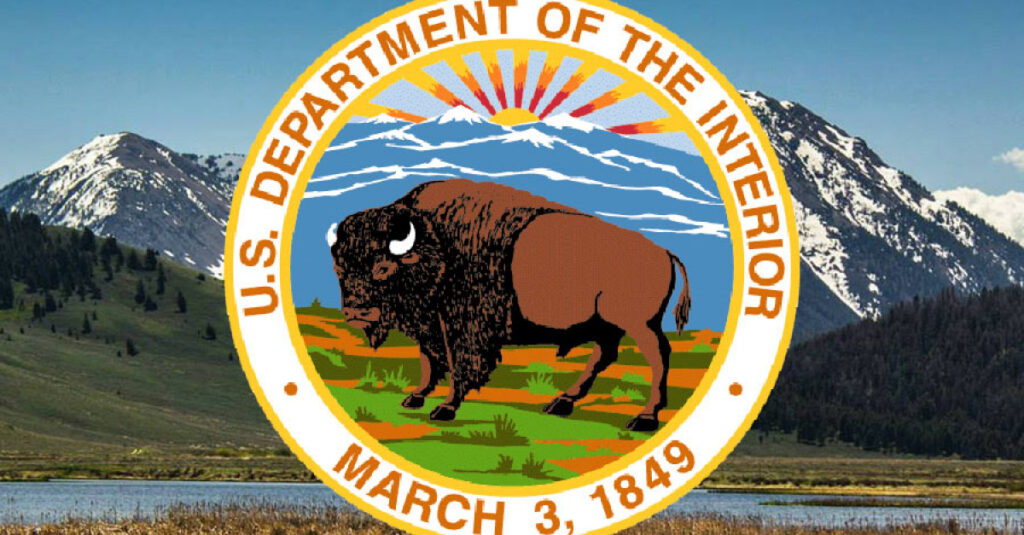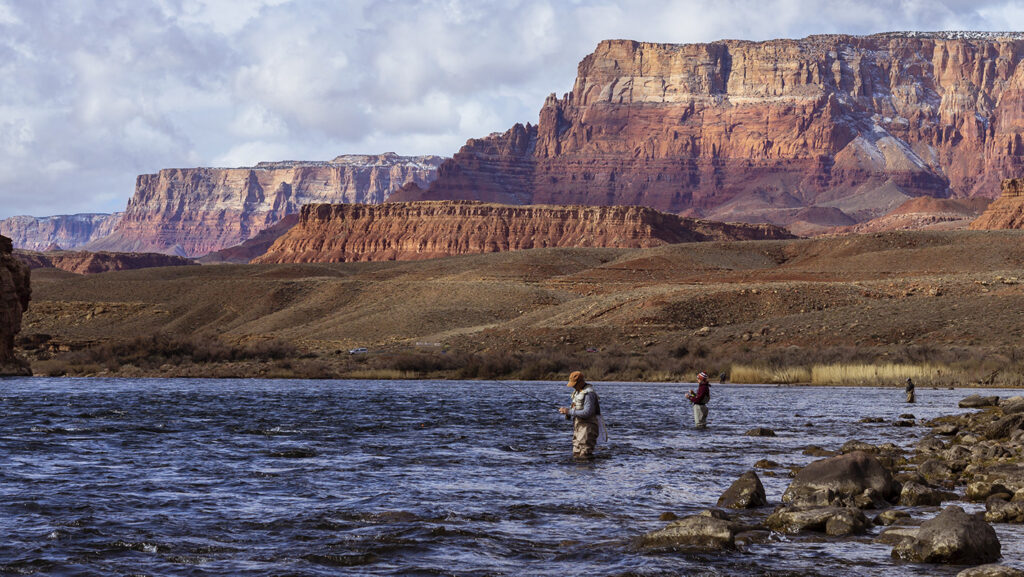
The Department of the Interior is supposed to manage both environmental conservation and mineral extraction. Because of these opposing interests, the balance between these imperatives tends to vary greatly under different administrations. As one might expect, priorities tend to shift toward conservation during liberal administrations and toward extraction during conservative ones. However, no administration has managed to diminish the pride and morale of career civil servants as much as the present one, according to two former top officials at the department.
The Water Desk spoke with Rebecca Watson and John Leshy, who visited the University of Colorado Boulder campus recently for an armchair debate hosted by the Getches-Wilkinson Center. Watson worked as Assistant Secretary for Land and Minerals Management under the George W. Bush administration and now is president of the Rocky Mountain Mineral Law Foundation. Leshy, now a professor of law at the University of California’s Hastings College of the Law, previously held the post of Solicitor for the Department of the Interior under President Clinton, and received the Defenders of Wildlife Legacy Award for lifetime contributions to wildlife conservation in 2013.
The following interview has been edited for brevity and clarity.
Water Desk: An ice breaker for both of you: What is your favorite national park?
Rebecca Watson: It’s easy for me: it’s Yellowstone and that’s why I moved to Cody, so I could live next to Yellowstone National Park. I was really struck by Hayden Valley the first time I went through.
John Leshy: I love them all. Yosemite probably is the one. Actually, my book is going to make the point that Yosemite was really the first national park, not Yellowstone … the feds gave it to the state, but to be managed in perpetuity under federal law, so that to me makes it kind of the first national park.
WD: So many environmental protections are being changed by executive order. What is the impact of using this governing tactic as opposed to passing bills in Congress?
JL: It’s certainly more durable to do it by legislation, although the formal executive orders do tend to have a bit of staying power. For example, when President Reagan came in in 1980, he did a number of executive orders on cost-benefit analysis and stuff like that, which subsequent Democratic administrations did not really change. I mean they tinkered with them, but they didn’t really change. So there is some stability in executive orders. But when you do something by executive order you always raise the question of do you have authority to do it, so it makes it challengeable in court.
WD: You both have talked about how the system is broken and there’s not as much working together as there used to be. Do you think that is one of the reasons we’re seeing so many of these rules change by executive order?
RW: Well, you saw it begin in President Obama’s administration when he faced kind of an intransigent legislature…So I think this is the response of the executive when they can’t work with a Congress. So, it’s not a surprise it’s been done before. Once somebody does it, then the next guy does it—or woman.
WD: What do you think the impact of that style of governing is at the ground level for the people who are impacted by these constant changes by executive orders, such as the recent Waters of the United States rule?
RW: This Waters of the U.S. rulemaking has been ongoing in the Clinton administration, Bush administration, Obama administration, and now Trump. It goes back and forth, and it’s a very important question of who has the authority over water in a state. Some is federal water. Some is managed by the state. Where’s that dividing line? So it’s a pretty fundamental question, and the different parties have a different viewpoint of it, so there is no settled opinion. The Supreme Court didn’t help things with a fractured five-part decision, which has led to all this confusion.
JL: It goes back actually to an ambiguity in 1972 [Clean Water Act], the first major claim to water, which gave the federal government regulatory authority over waters of the United States but had a very ambiguous definition of what Waters of the United States are. So, for the last 50 years, people, agencies, courts, administrations, have been sort of wrestling with this problem because it’s a difficult issue. If there were an easy answer somebody would have solved it a long time ago. And it does raise, as Rebecca said, not only the question of how do you define waters, but it raises this pretty fundamental question about local land-use authority versus national authority, because traditionally in this country, most land-use regulation has come through state and local governments. Not all—there’s always been some federal regulation—but this issue raises where’s that dividing line and that’s what makes it very controversial, very political.
The other reason it’s controversial and difficult is that the Clean Water Act was all about water quality. That’s what the regulation is designed to do, to protect water quality. But in protecting water quality you almost inevitably affect the allocation of water supply, which is a water rights issue. So you have water quality and water rights, and this rule, and this issue, is where that intersection is. Because water quality, by and large, is regulated by the federal government and water rights are regulated by the state government, you have conflict, so it really touches a lot of hot buttons.
WD: What implications might this new rule have for the way legislation like the Endangered Species Act is enforced?
JL: Well that’s complicated because the Endangered Species Act is a very complicated statute, but it has two thrusts, I mean the two sorts of places it goes. One is that it requires a consultation: anytime the federal government takes an action that could affect a listed endangered species, that’s when you have the consultation process and biological opinions, and there’s a whole regulatory apparatus that does that. But that only applies to federal action that the federal government takes, supports, permits or funds. And if there’s no federal funding, permitting, etcetera, the consultation process does not apply. But there’s another part of the Endangered Species Act, which makes it illegal for anyone—state, private, federal, anybody—to “take” a listed species, meaning harass, harm, kill, etcetera. That part is a universal application. So whatever the Waters of the United States rule says, and allows, the take problem is still a problem. The federal government really has no power under the Endangered Species Act to exempt anybody from the take except by the so-called God Squad, a cabinet-level committee with the head of the Corps of Engineers, the Interior Secretary and the EPA. These three people were given the power to exempt a project from the Endangered Species Act, which meant they were deciding that this species could be exterminated.
WD: Do you have a sense of how the culture has shifted in the Department of the Interior from the last administration to this one? Is it a starker contrast than in years past?
RW: I think the shift in this administration has been different from the perspective of the career employee. And I think, always when you have political appointees come into a building where they’re a thin layer on top of thousands of people, there’s always an “us versus them.” Especially when you’re following an administration that was the opposite party, you know…typically over six months or so you learn to work with them, learn to trust them and understand the role of a career civil service in our system, which is that they are to be apolitical. The people speak, they elect a president, he sets a policy and they help the political appointees implement that policy. That’s the way it’s supposed to work. And I think in this administration we’re seeing this play out right now with lists of suspected political appointees, much less the so-called “deep state” of career appointees that this administration has targeted. [The administration] has said very negative things about career people, and that matters to career people. That, I think, is a significant difference in my opinion and it’s not positive.
JL: I agree 100%. I mean, we both had experience in the Interior Department and I think probably agree on a lot of how it really works. And she’s exactly right that that layer of political appointees is, about as I remember, 50 people out of 70,000. Okay, so 69,950 people in the Interior Department are career civil servants, and they make the government go, and they actually make 99% of the decisions that you never hear about. And then the political people, you know, obviously have the power to because of elections to control and decide the big policy issues. And they do, they may decide them in the way that a lot of career people disagree with. But I think anybody who spent time in those big bureaucracies understands the bureaucracies have enormous responsibilities and the authority and the responsibility to make decisions that affect a lot of people’s lives. But they’re made, hopefully, in predictable, stable ways and life goes on, regardless of the administration. It is troubling what’s happening now because there really is this sort of assault on the career people and they feel under siege. I don’t know how it’ll turn out, but it’s not a healthy thing.
RW: People that work in the government, in those positions, they view themselves as public servants. They’re, you know, not people wearing halos necessarily, but they do have a source of pride. They work for the federal government, they are public servants, they’re doing something that matters to the American people. And to be denigrated and treated in a suspicious manner that has never ended for, you know, over three years of this administration—nobody would want to work under that kind of situation. It’s soul destroying, I think.
WD: The National Oceanic and Atmospheric Administration and U.S. Geological Survey have been told to scrape the phrase climate change and this is one of the cultural implications of the new administration. Do you have a sense of how unique this is?
JL: It’s certainly unusual. Everybody tries to shake things, I suppose, to serve your sort of political ends regardless of which administration it is. But I think the degree to which the control on the basic facts in this administration is pretty unprecedented. I don’t recall anything like that.
RW: In the Bush administration, one of our mantras, or clichés if you will, but was something we took seriously was “sound science.” You don’t hear that phrase anymore: “sound science.”
JL: You hardly even hear the phrase “science,” which is too bad because certainly natural resources, public lands, water facts control a lot of the policy. What’s going to happen if you do “x”? The basic facts are the bedrock of good resource management. And if you’re denying the facts, we’re in trouble.
RW: Science doesn’t set policy but it informs policy, and you have to trust the science and the basic facts to make decisions. So, being married to a scientist, I don’t like the disregard for scientific evidence. And, of course, as lawyers we need to get what the facts are. We have to hear from our clients, but then we have to look—okay, what’s the other side? The facts are important. I think scientific data is critical for the Interior Department.
JL: It’s not just sort of controlling what the factual reports are, but I think there’s a problem with the funding. Government does an awful lot of basic science, and the USGS does an awful lot of basic things that you never hear about in terms of assessing water quality and water quantity and earthquakes—it’s an essential function. Michael Lewis is a well-known author and his latest book [“The Fifth Risk”] is really interesting. It’s on what might be the most boring subject you could think of, which is science in the federal government and what’s happening to it. It’s about NOAA and the USGS. He’s a wonderful writer and he really tells a great story about this problem of destroying the kind of bedrock scientific capacity of the government and how dangerous it is, basically for everybody.
WD: John offered a book, so do you have any recommendations, Rebecca?
RW: I just read this book called “The Swamp” by Michael Grunwald on the Everglades. It’s just fascinating because he’s a reporter, so he writes really well. And he just takes a look at the Everglades, but it’s really the history of Florida. What were the Everglades like? He went back to the original diaries of the soldiers that were down there chasing the Native Americans that lived there. What did they see? And then the idiotic ideas they had to drain the Everglades: water flows downhill, they thought it’d be really easy. Well, they managed to screw everything up. So then during the Clinton administration I think was the first federal action to try and restore some of the functionality of the Everglades. So it’s just this amazing ecological history, Florida history. And, of course Florida, is full of really weird characters, so it’s a great read.

John Leshy biographhy
John Leshy joined the University of California, Hastings College of Law in fall 2001 after serving as Solicitor (General Counsel) of the U.S. Department of the Interior throughout the Clinton administration. Previously, he taught at Arizona State University College of Law (1980-1992), and served in the Interior Department in the Carter administration as special counsel to the Chair of the Committee on Natural Resources, U.S. House of Representatives, and with the Natural Resources Defense Council in California. He started his legal career as a litigator with the Civil Rights Division of the U.S. Department of Justice. In 2008 and 2009, Leshy co-chaired the Obama administration transition team for the Interior Department, after heading the Interior transition team for the Clinton administration in 1992 and 1993. In 2013, he received the Defenders of Wildlife Legacy Award for lifetime contributions to wildlife conservation.

Rebecca Watson biography
Rebecca Watson is a shareholder in the law firm of Welborn, P.C. in Denver and serves as president of the Rocky Mountain Mineral Law Foundation. She is the fourth woman to serve as president and is leading the foundation through its first strategic plan in its 66-year history. In her 40-year career, Watson has represented natural resource, oil and gas, and renewable energy clients as well as served in the federal government. As Assistant Secretary for Land and Minerals Management in the U.S. Department of Interior in the George W. Bush administration, she had oversight over three bureaus, including the Bureau of Land Management. Earlier, she served as Assistant General Counsel for Energy Policy at the U.S. Department of Energy. Watson was named the 2011 Distinguished Natural Resources Practitioner-in-Residence at the University of Denver’s Sturm College of Law, her alma mater. Watson is on the board of the Buffalo Bill Center of the West, a five-museum complex in Cody, Wyoming, where she recently moved.
Longform Story CSS Block



